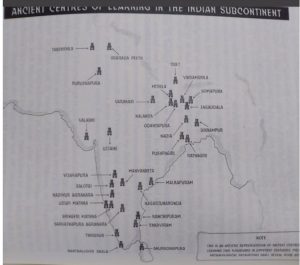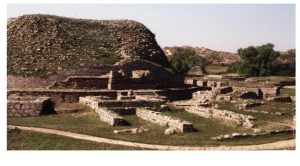Universities in Ancient Bharat

(Glorious Bhartiya Heritage-part 24)
Dr. Gauri Shankar Gupta
“India was the motherland of our race, and Sanskrit the mother of Europe’s languages: she was the mother of our philosophy; mother, through the Arabs, of much of our mathematics; mother, through the Buddha, of the ideals embodied in Christianity; mother, through the village community, of self-government and democracy.” – Will Durant, American Historian
 Centres of Higher Learning in India between 7th BCE and 12th AD
Centres of Higher Learning in India between 7th BCE and 12th AD
Education is the soul of any nation. Precisely for this reason, education in ancient India was accorded the highest priority and the guru (teacher) highest veneration, even higher than The Almighty. History of education in India goes back to the time of the Vedas when knowledge was passed orally from generation to generation called as shrutis. Subsequently, during the time of Ramayana and Mahabharata, Ashrams and Gurukuls came up where students used to live and learn with their teachers. When the Ashrams and Gurukuls of the Rishis started overflowing, naturally the larger much bigger institutions came into existenceknown as Matts or Vidya Peeths.
An objective and dispassionate look at the history of higher education in the world will reveal that India was replete with many institutions of higher education as early as 7th BCE. According to many historians, the roots of some of these institutions could be traced backas early as 2800 BCE or 4900 years ago. Takshashila(Taxila) in present day Pakistan, was the first ever university known to mankind. From 7th BCE to 12th AD Indian universities and centres of higher learning could be seen all over India. Sharada Peeth, Ujjaini, Nalanda, Vikramshila, Pushpagiri, Vallabhi, Somapura, Kanthalloor Sala and Kanchipuram are some of them. Students came from Greece, Arabia, Turkey, Persia, Tibet, China, South East Asia, Korea and Japan to these universities transferring knowledge to different parts of the world. The following is the brief description of five of these great institutions of learning covering different parts of India:
Entrance to the university was very tough and was based on an entrance examination. Only about 20% of the students who appeared for the entrance examination succeeded. The university attracted scholars from Korea, Japan, Indonesia, China, Tibet and Turkey. The scholars who studied at Nalanda include; Emperor Harshvardhana; Vedic scholars Viradeva, Suvishnu and Aryadeva;Chinese scholars Xuanzang and Yijing; and Buddhist scholars Dharampal, Asanga, Padmasambhava and Nagarjuna. On the pattern of Nalanda four other universities Jagaddala, Odantapura, Somapura and Vikramshila were set up in the surrounding region by the rulers of Pala Dynasty in the 8th century. These five great institutions in eastern India formed a state-supervised network and it was common for scholars to move from position to position among them. Each establishment had its own official seal.The ruins of the Nalanda University are on the world heritage site of UNESCO.
Pushpagiri University: Located in ancient Kalingaand present-day Odisha, Pushpagiri University was spread over three adjoining hills of Lalitgiri, Ratnagiri and Udaigiri. Several scholars believethat this university was established by Emperor Ashoka himself sometime in 3rd BCE andflourished until 14th AD. In any case it was older than Nalanda. The university campus was spread over three adjoining hills Lalitgiri, Ratnagiri and Udayagiri and contained several stupas, monasteries, temples and sculptures primarily in Gupta architectural style. The main stupa at Lalitgiri is 15 metres in diametres and constructed in Sanchi style. A large number of Buddhist artifacts have also been found in the archeological excavations in these hills. A 3rd century inscription of Andhra Ikshvaku King Virapurushaduttamentions of donations given by the King for setting up a stone mandapa at the university. Looking at the architecture and archeological artifacts, one can surmise that it was primarily a Buddhist learning centre.
The quality of education imparted in ancient India was unparalleled. Therefore, in spite of various hardship and hurdles, students from different parts of the world flocked to Indian universities. Amir Khusrau(1252-1325 A.D.) mentions that scholars have come from different parts of the world to study in India but no Indian scholar have found it necessary to go abroad to acquire knowledge. Caliphs like Al Mansur and Harun Al Rashid (754-809 A.D.) sent embassies to India to procure Indian scholars. Astronomical treatise like Brahmasiddhanta and the Khanda Khadyaka of Brahmagupta and the medical books of Charaka, Susruta and Vagbhatta were translated into Arabicduring 8-9th AD.
As a home of knowledge and wisdom ancient India produced scores of scholars. These include; GautamBuddha and Shankara (philosophy), Kautilya (political science and administration), Sushruta (surgery), Charaka (medicine), Kanada (physicist whopropounded the atomic theory), Nagarjuna (chemistry), Aryabhatta and Varahamihira (astronomy), Baudhayana and Brahmagupta (mathematics) and Patanjali (yoga) to name a few. Great Indian mathematicians discovered numerical, zero, decimal system, algebra and geometry. India was the first country to discover the solar system with nine planets (नवग्रह) and their movements. Ayurveda was the first ever health science discovered by humanity. The knowledge of ancient Indians in the field of metallurgy was extraordinary as it is evidenced by the Iron pillar at Delhi which till now has not rusted though exposed to elements for over 1500 years. How such a huge column was casted is still a mystery to scientists. The lofty temples found in Karnataka, Tamilnadu, Odisha and Khajuraho to name a few shows the expertise which ancient Indians had in Structural Engineering.
This glorious chapter of the institutions of higher learning in India started to end with the brutal Islamic invasions from 12th century onwards. Bhaktiyar Khilji, a Turkish Muslim invader in 1193 AD alone destroyed Nalanda, Vikramshila, Odantapuri, Jaggadala and Somapura. Teachers and students were killed, libraries were burnt and buildings ravaged. The Persian historian Minhaj-i-Siraj, in his chronicle the Tabaqat-I-Nasiri, reported that thousands of Buddhist monks were burned alive and thousands beheaded as Khiljitried his best to uproot Buddhism from India. Minhaj-i-Siraj writes that “the greater number of the inhabitants of those places were Brahmans, and the whole of those Brahmans had their heads shaven; and they were all slain”. The burning of the Nalanda library continued for several months and “smoke from the burning manuscripts hung for days like a dark pall over the low hills.” Kanauj and Kashi were looted and plundered. Temples and educational institutions and libraries were put to destruction and some of them were replaced by mosques. This process continued intermittently for almost 200 years when most of these great universities were completely destroyed.

